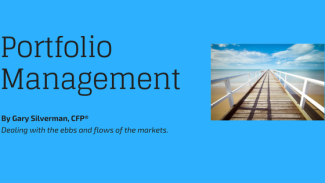
Portfolio Management: Comfortable Uncertainty
By Gary Silverman, CFP®
In the past columns we talked about some of the factors you need to consider when building your investment portfolio. There’s the basic portfolio itself: Buying what you think will go up the most across the time you have to keep your money invested. Then there was the issue of reducing the risk of the portfolio to something that you situation and your gut can live with. Part of that was to ensure that your near-term cash needs are kept out of risking investments.
Building a portfolio is one thing, managing it is another. And while there are some specific techniques that can be used, what I want to cover is more my philosophy of how to deal with the ebbs and flows of the markets. Because I am as much an emotional being as anyone else, I can be swayed by popular opinion, become euphoric when I make a home run, and get dejected when my investment ideas end up in the red. To guard against making stupid decisions based on this, over the next several columns I’ll be examining some of the things we, as a firm, keep in mind. This should help you as you begin your own portfolio maintenance.
Let’s start with uncertainty. This is what makes markets bounce around. Keeping in mind the economic, political, societal, technological, and other uncertainties makes you appreciate why the market doesn’t just smoothly go up. And it is easy to start second-guessing yourself if things don’t go your way for a while.
In August 1979, Business Week’s front cover declared “The Death of Equities.” It was a bleak time in the nation’s economic history. Inflation, interest rates and energy prices were at an all-time high, and 7 million shareholders had abandoned the stock market since 1970. “Only the elderly who have not understood the changes in the nation’s financial markets, or who are unable to adjust to them, are sticking with stocks,” concluded Business Week. Those that read and followed the teachings of that article missed out on a great bull market that lasted until 1987.
That bull market ended spectacularly on October 19, 1987. That day, Warren Buffet lost $342 million of his own private holdings in Berkshire Hathaway. Actually that’s not true. What is true is that his portfolio’s value went down $342 million. He didn’t lose anything. He didn’t lose because he didn’t sell. If he had sold, he would have missed an even greater bull market that was yet to come.
Therein lies the secret to all investing: markets don’t create losses—real, permanent capital losses. People making irrational and counterintuitive (stupid) judgments create real losses.
The key is to keep your focus on where you are going. There is no harm in letting poor performance cause you to question the strategies and tactics you’ve chosen for your portfolio. If they prove to be sound approaches that have worked over time rather than a series of hunches then you’re probably okay.
Uncertainty and the variability that surrounds it are just part of the process.
Gary Silverman, CFP® is the founder of Personal Money Planning, LLC, a Wichita Falls retirement planning and investment management firm and author of Real World Investing.

